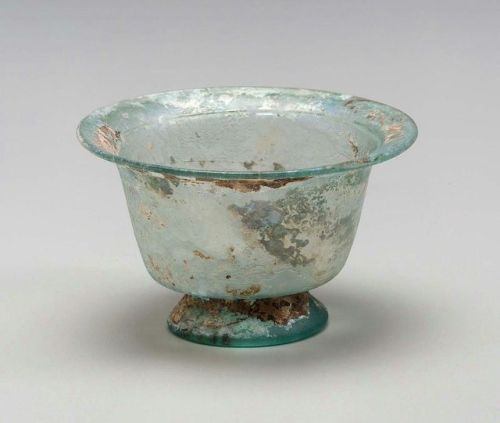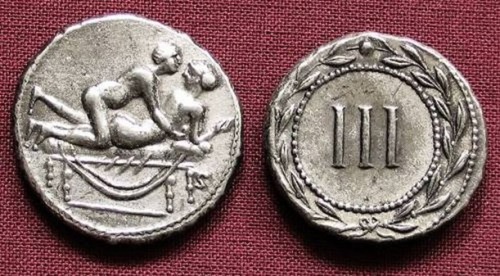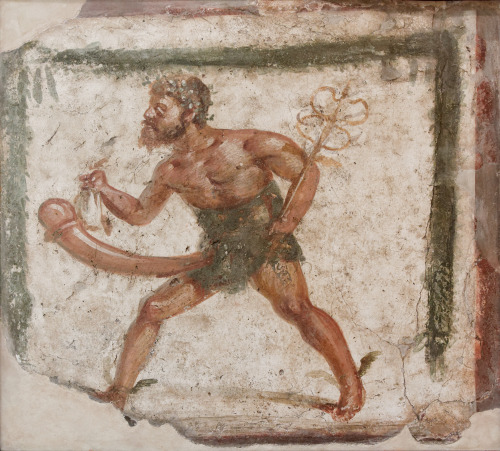#1st century




Hieros gamos (wedding) of Zeus and Hera from the House of the Tragic Poet in Pompeii 1st C. CE
“The local myth relayed by Menodotus of Samos contains references to cult ceremonies and practices. It is believed that Admete, daughter of Eurystheus fled from Argos to Samos. To punish her for fleeing, the Argives instructed Etruscan pirates to carry the wooden Samian cult image away. However the pirate ship with the stolen cult image was unable to set off and the pirates escaped in confusion. When the Samian islanders discovered their image outside the temple they assumed it had escaped alone and bound it with rods from the Lygos tree. Thus the annual festival of Hera was called the Tonaia (binding) where the main ceremony involved participants dragging the image out of the temple and to the seashore where they would then make a great show out of searching for the statue and uncovering it for it to be purified. Varro states the statue was draped with bridal robes as ‘The annual rites of Hera are celebrated in the form of a marriage’ thus the festival sought to immitate marriage rites between Hera and Zeus. The Goddess’ birthplace is also involved in the festival where cult members wound lygos branches around themselves from the sacred tree Hera is believed to have been born under.
The remnants of fruit such as grape seeds and olive pits show us evidence of the types of fruit consumed during the festival of Hera. It was believed fruits rich in seed reflected Hera’s divinity as a great fertility Goddess.”
-taken from Warwick.ac.uk
https://paganimagevault.blogspot.com/2020/06/hieros-gamos-wedding-of-zeus-and-hera.html










“Funerary altar of Iulia Victorina. Marble. Last quarter of the 1st century CE. The altar is dedicated to the en:manes of Iulia Victorina dead at 10 years and 5 months old. Purchase 1863. Louvre museum (Paris, France). Portrait on the front of the 10 year old girl at her death, garlanded in a floral frame, and on the back as the young matrona she would never become. Trees on each (side). Color by @chapps on twitter.
While Julia Victorina is only one child in the unhappy statistic that half of all Roman children died by the age of ten, her death in the last quarter of the 1st century CE is personalized by the unique and costly monument her parents set up in her memory. With this elegant altar, now in the Louvre Museum in Paris, Gaius Julius Saturninus and Lucilia Procula, who are otherwise unknown by rank, ancestry, or situation, memorialized their grief and hopes for a young daughter taken from them prematurely. The monument would have been placed in a family tomb and held a cinerary urn containing the child’s ashes. It is a rectangular block of white marble, elaborately carved on all four sides and crowned by a marble cover gracefully decorated with motifs (mouldings, volutes, and blossoms) that echo those carved on the front and back of the lower stone. The front of the altar bears the dedicatory inscription and features a portrait bust in high relief of the lovely face of a girl, framed by a wide border of acanthus leaves and variegated flowers, symbols in the Mediterranean world of eternal life. Julia Victorina, gazing pensively off to her right, wears ball-shaped pendent earrings, probably of gold; her shoulders are draped, her hair is styled almost boyishly and is crowned by a crescent moon, at once a symbol of eternity and association with Diana in her role as the moon-Goddess. On the back of the altar she appears again, similarly framed with botanicals, but now as a young matrona, as her parents had hoped in a few years to enjoy her; her face is solemn and thinner but recognizable as the child she was. She looks directly at the viewer, wearing the married woman’s stola, a palla draped over one shoulder and the same pendent earrings; her hair is arranged in a more matronly style, topped by a radiate crown that symbolizes her apotheosis in the heavens and her immortality. The short sides of the altar are decorated with a flourishing laurel tree, an evergreen sacred to Apollo, God of the sun; within its branches hover two birds, possibly ravens, his sacred bird, seen here together with laurel-crowned Apollo in his shrine. This extraordinary altar, with its portrait busts and floral designs promising immortality, offers moving testimony to the grief of Victorina’s parents over the loss of a beloved child.
The dedicatory inscription is crowded into the space below the child’s bust, which awkwardly divides the girl’s cognomen. The words are written in square capitals over five lines of diminishing size, with prominence given to the Di Manes and the girl’s name. The letters are well formed and centered, with medial dots (interpuncts) separating the words in lines 3-6.
Latin:
D[is] M[anibus]
IVLIAE VIC TORINAE
QVAE• VIX[it]• ANN[is] • X• MENS[ibus]• V•
C[aius]• IVLIVS• SATVRNINVS• ET
LVCILIA• PROCVLA• PARENTES
FILIAE• DVLCISSIMAE• FECERVNT
English:
To the spirits of the dead
Julia Victorina
Who lived for ten years and five months
Gaius Julius Saturninus and
Lucilia Procula
Parents of this sweetest daughter
Had this monument made
Notes to Funerary Inscription for Victorina:
Di Manes, m. pl.
the collective spirits of the dead, the divine spirits. DM is a common abbreviation for the dedication of a funerary monument to the spirits of the dead and thus is in the dative case. These letters or the words they stand for are regularly found at the head of funerary inscriptions dating from the end of the 1st century BCE through the 2nd century CE.
Iulia, -ae f.
Julia is the proper name of women born into the gens Iulia. Victorina appears to have inherited the nomen gentilicium from her father. The name of the deceased is either in the dative case as the dedicatee of the inscription, or the genitive as the possessor of the DM.
Victorina, -ae f.
The dead girl’s cognomen.
menses, menses m.
month. Both annis and mensibus are ablatives of time following vixit. Some inscriptions included days as well.
Saturninus, -i m.
The cognomen of Victorina’s father is found during the Republic and the Empire. There was a centurian named Gaius Iulius Saturninus who came from Chios and served under the Flavians in a unit of Spaniards in Egypt, but no firm connection can be made.
Lucilia, -ae f.
Lucilia is the proper name of women born into the gens Lucilia; Victorina’s mother’s cognomen is Procula.
parens, -entis m./f.
parent. It is in the nominative plural, in apposition with Saturninus and Procula, who are the subjects of the verb fecerunt.
dulcis, -e
sweet, lovely, dear, kind. The adjective is in the superlative degree. It modifies filiae; both are in the dative case, in apposition with Iuliae Victorinae.
[hoc monumentum]
this phrase normally follows the verb of dedication (fecit/fecerunt) in funerary inscriptions. Monumentum is the regular word for a Roman tombstone. Sometimes the entire formula is omitted as unnecessary or for lack of space or money.”
-taken from feminaeromanae, vroma, and wikipedia
More pictures and sources on my blog: https://paganimagevault.blogspot.com/2022/05/funerary-altar-of-iulia-victorina-1st-c.html
Villa Poppaea, Oplontis, Italy, 1st century
excarvated in 1964
Photo:otdelnovpavel
Today’s piece of erotic art history is a spintrae coin (”spintria” when plural) which comes to us from the 1st century CE Rome. The purpose of these coins are still debated. The popular press has most frequently popularized them as “brothel tokens” (1,2), however, given that there are non-erotic versions of the same coins with the Roman numerals I-XVI (1-16) on them, the most likely explanation is that they are game pieces (2) thereby making them the equivalent to a “dirty deck” of cards.
In this scene, a fully nude man approaches his equally nude female partner from behind on an opulent bed as she turns to face him. The man is either already penetrating or is moments from penetrating his partner as she lays on her stomach and rests her weight on one arm as she arches her back to turn to face her partner.
REFERENCE / FURTHER READING
(1) WIKIPEDIA ARTICLE: “Spintria”
https://en.wikipedia.org/wiki/Spintria
(2) THE NUMISMATIC BIBLIOMANIA SOCIETY ARTICLE: “Spintriae are no Brothel Tokens”
www.coinbooks.org/esylum_v15n05a09.html
BOOKS FACT ARTICLE: “Spintriae Ancient Rome Token with Sexual Acts and Symbols“
^^ (CONTAINS EXCELLENT ADDITIONAL EXAMPLES OF SPINTRIA)
https://www.booksfact.com/archeology/spintriae-ancient-rome-token-sexual-acts-symbols.html
Post link
Today’s piece of erotic art history is a fresco from Pompeii dated between 50-79 CE. This character is frequently mis-identified as Priapus, a god commonly depicted with an giant undying raging erection, but this is actually the messenger god, Mercury (previously known as Hermes to the Greeks) as is denoted by several key identifying attributes in this picture including the wings on his feet, his purse, and his caduceus (1) (a signifying staff with two entwining snakes and a pair of wings at the top typically carried in Mercury / Hermes’ left hand (2)).
Though Priapus is well known for his phallic representations, Mercury / Hermes had a strong phallic association, as well, as is depicted in statues known as herma*. (3) Mercury / Hermes was the god of boundaries and herma were tall statues with flat rectanglular bases with a bust of Hermes at the top and male genitals carves into the otherwise featureless base at the appropriate height which marked borders in lieu of fences. In this scene, wearing only a loin cloth, Mercury walks at an ambitious pace with wings on his feet, his caduceus in his left hand, his pouch in his right hand, and is preceded by his large and improbably shaped erection which is both longer and larger than his arms.
* NOTE - There will be examples of herma uploaded into the database in the future (and may already be present if you are reading this article past its time of publication) which can be found using the #herma hashtag, found below.
REFERENCE / FURTHER READING
(1) WIKIPEDIA ARTICLE: “Hermes”
https://en.wikipedia.org/wiki/Hermes
(2) WIKIPEDIA ARTICLE: “Caduceus”
https://en.wikipedia.org/wiki/Caduceus
(3) WIKIPEDIA ARTICLE: “Herma”
https://en.wikipedia.org/wiki/Herma
WIKIPEDIA ARTICLE: “Pompeii”
https://en.wikipedia.org/wiki/Pompeii
Post link
A bird among the shrubs and flowers of a garden. A detail of Pompeian wall painting, 1st century AD. This painting exemplifies the Roman passion for gardens and countryside.
Post link
Fighting women of the Germanic tribes
During the expansion of their empire, the Romans sometimes encountered female commanders and female fighters. Some of them belonged to the Germanic tribes. Most accounts depict these women fighting in desperate situations, but they are shown as deadly and uncompromising.
Among these were the Cimbrian women. The Cimbri’s ethnicity is still subject to debate today. Some say that they were Germans, others that they were Celts. They had migrated from FrisiaandJutland and descended toward Italy and several clashes with the Romans followed. In 101 BCE, the Cimbri faced the troops of consul Gaius Marius at Vercellae.
The Cimbrian warriors were defeated, which led the women to take arms, even though the extent of these activities remain unclear. Indeed, according to the account of Florus:
“There was quite as severe a struggle with the women-folk of the barbarians as with the men; for they had formed a barricade of their waggons and carts and, mounting on the top of it, fought with axes and pikes.”
The women sent a delegation to Marius, but failed to secure their freedom. They therefore killed their children and committed suicide. Plutarchgives a slightly different account of the battle, saying that the women fell upon the men who tried to flee and killed them, including their husbands and relatives, and then committed suicide.
Women of the Ambrones , an allied tribe of the Cimbri, displayed the same behavior at Aquae Sextiae. Plutarch gives the following description of the Ambrones’ defeat:
“(…)The Romans kept slaying them until they came in their flight to their camp and waggons. Here the women met them, swords and axes in their hands, and with hideous shrieks of rage tried to drive back fugitives and pursuers alike, the fugitives as traitors, and the pursuers as foes; they mixed themselves up with the combatants, with bare hands tore away the shields of the Romans or grasped their swords, and endured wounds and mutilations, their fierce spirits unvanquished to the end.”
Cassius Dio also writes that during the war with the Marcomanni (166 until 180) the bodies of women wearing armor were found on the battlefield.
TheHistoria Augusta also mentions that during the triumph of Aurelian:
“There were led along also ten women, who, fighting in male attire, had been captured among the Goths after many others had fallen; these a placard declared to be of the race of the Amazons — for placards were borne before all, displaying the names of their nations”.
This last source isn’t, however, a reliable one, so this story must be regarded with some skepticism.
Bibliography:
Cassius Dio, Roman history
Chrystal Paul, Women at war in the classical world
Florus,Epitome
Historia Augusta
Plutarch,Parallel Lives
Post link

~ Urn and cover.
Culture/Period: Roman Imperial
Date: A.D. late 1st-early 2nd century with later restorations of base and lid
Medium: Alabaster (travertine).






